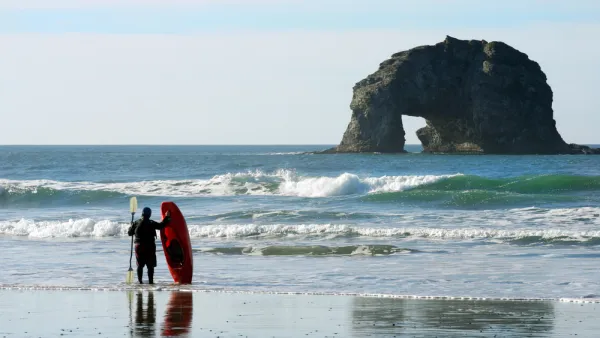And now those property owners are putting barbed wire over the river to keep out "trespassers."

An article by Cassidy Randall has raised the national profile of a battle over public access to streams taking place in New Mexico.
Up until recently, "the fate of public waterways has largely flown under the radar" in New Mexico, writes Randall. "Now New Mexico has become a battleground for that very issue, with the state government, landowners, and outfitters on one side of the fight and anglers, boaters, recreationalists and heritage users on the other. At the heart of the argument: who owns the water that has long been considered the lifeblood of the arid west."
Boaters and fishermen have long known that there are places you can't step on shore, but you're still free to float down the river. Commercial whitewater rafting outfits implement quiet zones along stretches of rivers where private landowners have raised concerns about commercial operators passing by. "Private landowners have long taken unsanctioned steps to keep the public out of waterways, as in the recent case of an Arizona man convicted of shooting at kayakers boating down a river that runs through his land," according to Randall. So what's different about New Mexico's case?
According to Randall, "in the last hours of 2015, efforts to bar public access received official sanction, when New Mexico’s state government quickly and quietly passed a bill that implies private ownership of public waters that run through private land."
"The rule remained mostly dormant until late December, when in a special meeting with only 10 days’ notice – just a third of the 30-day standard – the state began a process to allow landowners to certify streambeds as private property," adds Randall. That has led to landowners placing barbed wire across rivers, like in an example described in the article on the Pecos River.
FULL STORY: Who owns water? The US landowners putting barbed wire across rivers

National Parks Layoffs Will Cause Communities to Lose Billions
Thousands of essential park workers were laid off this week, just before the busy spring break season.

Retro-silient?: America’s First “Eco-burb,” The Woodlands Turns 50
A master-planned community north of Houston offers lessons on green infrastructure and resilient design, but falls short of its founder’s lofty affordability and walkability goals.

Delivering for America Plan Will Downgrade Mail Service in at Least 49.5 Percent of Zip Codes
Republican and Democrat lawmakers criticize the plan for its disproportionate negative impact on rural communities.

Test News Post 1
This is a summary

Test News Headline 46
Test for the image on the front page.

Balancing Bombs and Butterflies: How the National Guard Protects a Rare Species
The National Guard at Fort Indiantown Gap uses GIS technology and land management strategies to balance military training with conservation efforts, ensuring the survival of the rare eastern regal fritillary butterfly.
Urban Design for Planners 1: Software Tools
This six-course series explores essential urban design concepts using open source software and equips planners with the tools they need to participate fully in the urban design process.
Planning for Universal Design
Learn the tools for implementing Universal Design in planning regulations.
EMC Planning Group, Inc.
Planetizen
Planetizen
Mpact (formerly Rail~Volution)
Great Falls Development Authority, Inc.
HUDs Office of Policy Development and Research
NYU Wagner Graduate School of Public Service




























